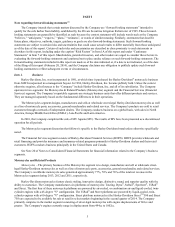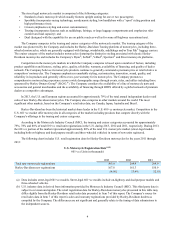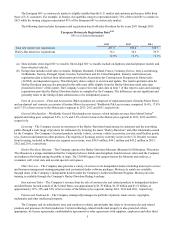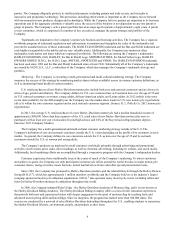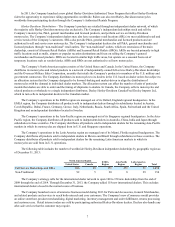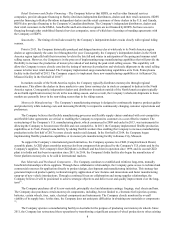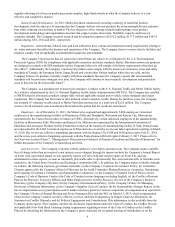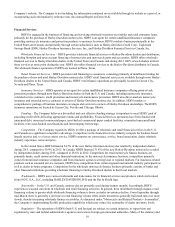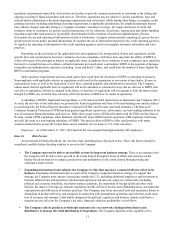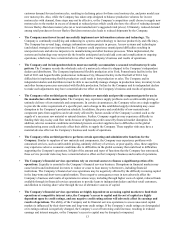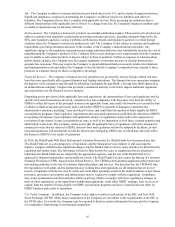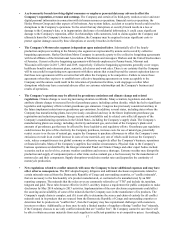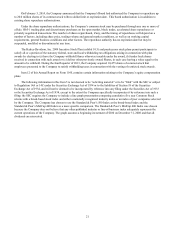Harley Davidson 2013 Annual Report Download - page 13
Download and view the complete annual report
Please find page 13 of the 2013 Harley Davidson annual report below. You can navigate through the pages in the report by either clicking on the pages listed below, or by using the keyword search tool below to find specific information within the annual report.13
customer demand for used motorcycles, resulting in declining prices for those used motorcycles, and prior model year
new motorcycles. Also, while the Company has taken steps designed to balance production volumes for its new
motorcycles with demand, those steps may not be effective, or the Company’s competitors could choose to supply new
motorcycles to the market in excess of demand at reduced prices which could also have the effect of reducing demand
for new Harley-Davidson motorcycles (at or near manufacturer’s suggested retail prices). Ultimately, reduced demand
among retail purchasers for new Harley-Davidson motorcycles leads to reduced shipments by the Company.
• The Company must invest in and successfully implement new information systems and technology. The
Company is continually modifying and enhancing its systems and technology to increase productivity and efficiency.
The Company has several large, strategic information system projects in process. As new systems and technologies
(and related strategies) are implemented, the Company could experience unanticipated difficulties resulting in
unexpected costs and adverse impacts to its manufacturing and other business processes. When implemented, the
systems and technology may not provide the benefits anticipated and could add costs and complications to ongoing
operations, which may have a material adverse effect on the Company’s business and results of operations.
• The Company and its independent dealers must successfully accommodate a seasonal retail motorcycle sales
pattern. The Company records the wholesale sale of a motorcycle when it is shipped to the Company’s independent
dealers and distributors. The Company implemented flexible production at its York, Pennsylvania facility in the first
half of 2013 and began flexible production at its Kansas City, Missouri facility in the first half of 2014. Any
difficulties in implementing flexible production could result in lost production or sales. The Company and its
independent dealers and distributors must be able to successfully manage changes in production rates, inventory levels
and other business processes associated with flexible production. Failure by the Company and its independent dealers
to make such adjustments may have a material adverse effect on the Company’s business and results of operations.
• The Company relies on third party suppliers to obtain raw materials and provide component parts for use in
the manufacture of its motorcycles. The Company may experience supply problems such as unfavorable pricing or
untimely delivery of raw materials and components. In certain circumstances, the Company relies on a single supplier
to provide the entire requirement of a specific part, and a change in this established supply relationship may cause
disruption in the Company’s production schedule. In addition, the price and availability of raw materials and
component parts from suppliers can be adversely affected by factors outside of the Company’s control such as the
supply of a necessary raw material or natural disasters. Further, Company suppliers may experience difficulty in
funding their day-to-day cash flow needs because of tightening credit caused by financial market disruption. In
addition, adverse economic conditions and related pressure on select suppliers due to difficulties in the global
manufacturing arena could adversely affect their ability to supply the Company. These supplier risks may have a
material adverse effect on the Company’s business and results of operations.
• The Company relies on third parties to perform certain operating and administrative functions for the
Company. Similar to suppliers of raw materials and components, the Company may experience problems with
outsourced services, such as unfavorable pricing, untimely delivery of services, or poor quality. Also, these suppliers
may experience adverse economic conditions due to difficulties in the global economy that could lead to difficulties
supporting the Company's operations. In light of the amount and types of functions that the Company has outsourced,
these service provider risks may have a material adverse effect on the Company's business and results of operations.
• The Company’s financial services operations rely on external sources to finance a significant portion of its
operations. Liquidity is essential to the Company’s financial services business. Disruptions in financial markets may
cause lenders and institutional investors to reduce or cease to loan money to borrowers, including financial
institutions. The Company’s financial services operations may be negatively affected by the difficulty in raising capital
in the long-term and short-term capital markets. These negative consequences may in turn adversely affect the
Company’s business and results of operations in various ways, including through higher costs of capital, reduced funds
available through its financial services operations to provide loans to independent dealers and their retail customers,
and dilution to existing share value through the use of alternative sources of capital.
• The Company’s financial services operations are highly dependent on accessing capital markets to fund their
operations at competitive interest rates, the Company’s access to capital and its cost of capital are highly
dependent upon its credit ratings, and any negative credit rating actions will adversely affect its earnings and
results of operations. The ability of the Company and its financial services operations to access unsecured capital
markets is influenced by their short-term and long-term credit ratings. If the Company’s credit ratings are downgraded
or its ratings outlook is negatively changed, the Company’s cost of borrowing could increase, resulting in reduced
earnings and interest margins, or the Company’s access to capital may be disrupted or impaired.


